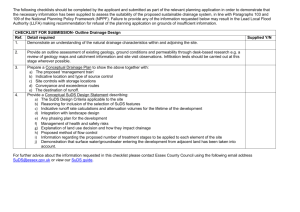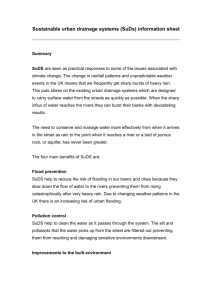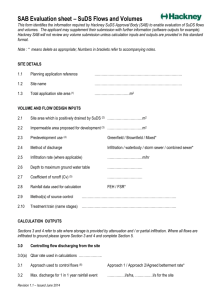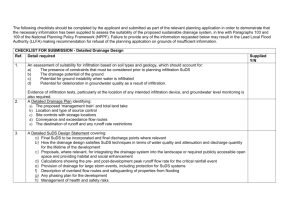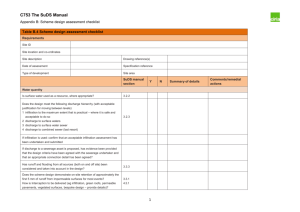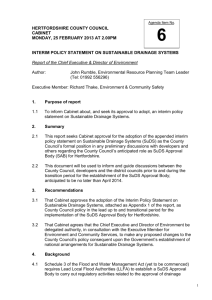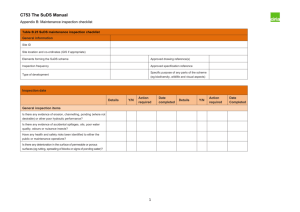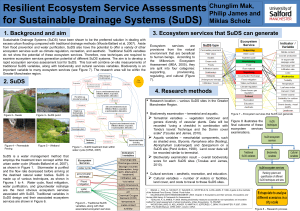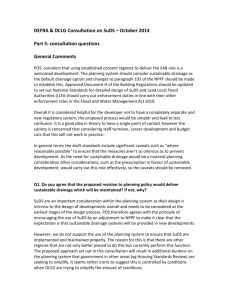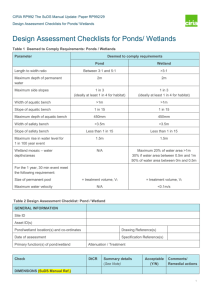Towards best management of runoff in new developments
advertisement
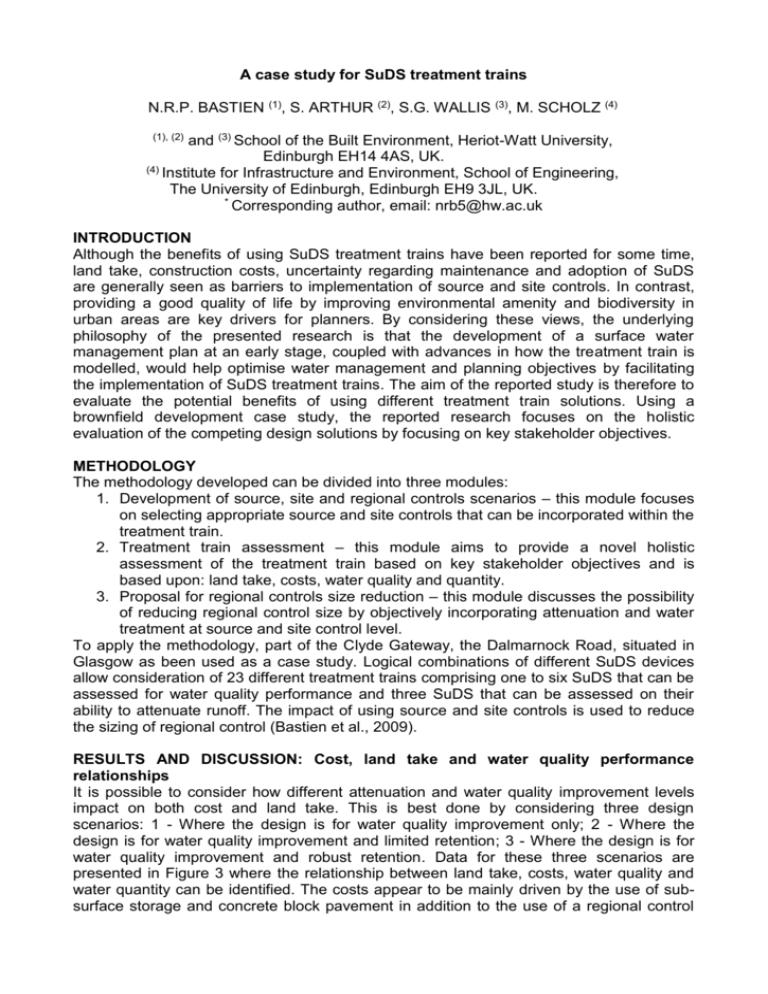
A case study for SuDS treatment trains N.R.P. BASTIEN (1), S. ARTHUR (2), S.G. WALLIS (3), M. SCHOLZ (4) (1), (2) and (3) School of the Built Environment, Heriot-Watt University, Edinburgh EH14 4AS, UK. (4) Institute for Infrastructure and Environment, School of Engineering, The University of Edinburgh, Edinburgh EH9 3JL, UK. * Corresponding author, email: nrb5@hw.ac.uk INTRODUCTION Although the benefits of using SuDS treatment trains have been reported for some time, land take, construction costs, uncertainty regarding maintenance and adoption of SuDS are generally seen as barriers to implementation of source and site controls. In contrast, providing a good quality of life by improving environmental amenity and biodiversity in urban areas are key drivers for planners. By considering these views, the underlying philosophy of the presented research is that the development of a surface water management plan at an early stage, coupled with advances in how the treatment train is modelled, would help optimise water management and planning objectives by facilitating the implementation of SuDS treatment trains. The aim of the reported study is therefore to evaluate the potential benefits of using different treatment train solutions. Using a brownfield development case study, the reported research focuses on the holistic evaluation of the competing design solutions by focusing on key stakeholder objectives. METHODOLOGY The methodology developed can be divided into three modules: 1. Development of source, site and regional controls scenarios – this module focuses on selecting appropriate source and site controls that can be incorporated within the treatment train. 2. Treatment train assessment – this module aims to provide a novel holistic assessment of the treatment train based on key stakeholder objectives and is based upon: land take, costs, water quality and quantity. 3. Proposal for regional controls size reduction – this module discusses the possibility of reducing regional control size by objectively incorporating attenuation and water treatment at source and site control level. To apply the methodology, part of the Clyde Gateway, the Dalmarnock Road, situated in Glasgow as been used as a case study. Logical combinations of different SuDS devices allow consideration of 23 different treatment trains comprising one to six SuDS that can be assessed for water quality performance and three SuDS that can be assessed on their ability to attenuate runoff. The impact of using source and site controls is used to reduce the sizing of regional control (Bastien et al., 2009). RESULTS AND DISCUSSION: Cost, land take and water quality performance relationships It is possible to consider how different attenuation and water quality improvement levels impact on both cost and land take. This is best done by considering three design scenarios: 1 - Where the design is for water quality improvement only; 2 - Where the design is for water quality improvement and limited retention; 3 - Where the design is for water quality improvement and robust retention. Data for these three scenarios are presented in Figure 3 where the relationship between land take, costs, water quality and water quantity can be identified. The costs appear to be mainly driven by the use of subsurface storage and concrete block pavement in addition to the use of a regional control pond. Whereas land take is driven by the use of swales and linear wetlands. Green roofs and water butts have a relatively limited impact in comparison to the use of other SuDS. These plots can serve as a basis for discussion between all the stakeholders involved in the drainage of the Dalmarnock Road area. Figure 1a: Cost size attenuation relationship when no attenuation is required Figure 3b: Cost size attenuation relationship with 30 years attenuation With: TSS removal (%): CBP Concrete Block Pavement RP Regional Pond SS Sub-surface Storage SW Swales Figure 3c: Costs size attenuation relationship with 100 years attenuation CONCLUSIONS It can be concluded that a novel methodology has been presented which offers an opportunity for the key stakeholders involved in the drainage of surface runoff in urban areas to maximize the benefits of using SuDS in a treatment train. The reduction in regional land take can be achieved based on water quality performance or source and site control attenuation. Despite the problems associated with offsetting regional land take with source and site controls, it has been shown that a different footprint for SuDS can be achieved by using SuDS in series rather than as an end-of-pipe control. The results obtained should be seen within the context of several SuDS related considerations which will vary greatly between catchments: land value in urban areas; increased amenity and biodiversity in urban areas; better management of accidental pollution and improved degradation of pollutants. REFERENCES Bastien N, Arthur S, Wallis S, Scholz M., (2009). Towards the best management of SuDS treatment trains. 13th DIPCON conference, Seoul, Korea, 12-15 October 2009.
